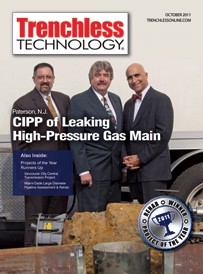Repair of Pipes with Wet Layup Carbon FRP (CFRP)
 The wet layup system is one of the most effective ways of strengthening high pressure pipes. In one of the first applications of this technique, QuakeWrap® products were used to repair 120-inch (3-m) diameter Prestressed Concrete Cylinder Pipes (PCCP) for the largest U.S. Nuclear Power Plant in the fall 1998 and 1999.
The wet layup system is one of the most effective ways of strengthening high pressure pipes. In one of the first applications of this technique, QuakeWrap® products were used to repair 120-inch (3-m) diameter Prestressed Concrete Cylinder Pipes (PCCP) for the largest U.S. Nuclear Power Plant in the fall 1998 and 1999.
In this technique, bands of carbon fabric that are typically 2-4 ft (600-1200 mm) wide are saturated with our epoxy resin and are applied as bands in the hoop direction. The ends of these bands are overlapped to provide a continuous loop. Our engineers will provide the necessary design calculations for the number of layers of carbon and the overlap lengths for each project.  The bands of fabric will also be overlapped along the length of the pipe; this will ensure that the fluids will flow from one band to the next, like roof shingles.
The bands of fabric will also be overlapped along the length of the pipe; this will ensure that the fluids will flow from one band to the next, like roof shingles.

In some cases, it may be more efficient to saturate the rolls of fabric outside the pipe and pass it into the pipe through the access ports. Inside the pipe, crew can deliver the rolls of epoxy-saturated fabric to the installation team.
For smaller diameter pipes (24-inch or 600-mm in diameter and smaller), where man entry is not possible, repairs have to be performed with the aid of a packer. These are balloon-like devices that can serve as a tool to deliver the Carbon FRP fabric to the repair area. The Carbon FRP fabric is saturated with resin and wrapped around the packer. The packer is then pulled into position with the help of a closed circuit camera and at that time the packer is inflated, pressing the Carbon FRP against the host pipe.  Once the FRP is cured, the packer is deflated and pulled out. This approach is ideal for spot repair of pipes. It can be repeated over and over to repair a longer section of a pipeline.
Once the FRP is cured, the packer is deflated and pulled out. This approach is ideal for spot repair of pipes. It can be repeated over and over to repair a longer section of a pipeline.
Once the installation of carbon FRP is complete, a final top coat is usually applied to the entire pipe surface as shown here. This epoxy coating is designed to provide further protection for the carbon FRP lining. QuakeWrap engineers will work with the client in selecting the proper top coat considering such factors as abrasion resistance requirements, chemical composition of the water, etc.

In certain projects, the client may require a carbon FRP lining that will work independently of the host pipe. That is, the liner should resist both internal fluid pressures as well as the external loads from soil, traffic, etc. This typically leads to many layers of carbon FRP that will have to be installed to build a thick enough liner with sufficient strength against buckling. In the project shown on the right, a 42-inch (1000-mm)steel pipe in a waste treatment facility in southern California carried hot air. The pipe that was located under the roadway required 8 layers of Carbon FRP to be installed. You can read the details of this project in this technical paper. QuakeWrap was the only FRP company that could offer a resin system to withstand the high temperature requirements of this project.
In response to the above applications where the time and the cost associated with installing many layers of Carbon FRP may become unacceptable to our clients, Professor Ehsani invented the concept of honeycomb pipes (StifPipe™). This unique pipe allows significant time and cost savings in many pipeline rehabilitation projects. We invite you to visit our PipeMedic website and learn more about this pipe by clicking here.

The QuakeWrap® wet layup system meets the NSF-61 ANSI Standards for potable water pipes and tanks. The system is approved for pipes 8-inch (200-mm) in diameter and larger, making it an ideal solution to water pipes of virtually all sizes. You can obtain a copy of the NSF certification by clicking here.

On September 16, 2009, Professor Ehsani offered a webinar entitled ” The Latest Innovation in Pipe & Culvert Repair Using Carbon FRP,”. The event was very well-received with over 440 individuals from 18 countries participating in this live webinar.
Click here to watch a video of the entire one-hour long presentation.
Participants in the webinar were asked to watch a few videos related to FRP. There were also handouts associated with the webinar. You can find out more about those videos and handouts by visiting here.

